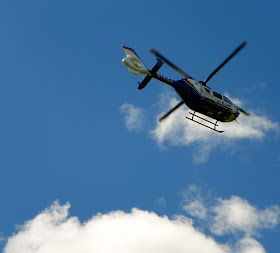Only took Life Flight helicopter 15 minutes to make rendezvous point
Amherst Fire Department responded around 11:00 AM this morning to a motorcycle accident on Shutesbury Road, Leverett, only about a 100 yards shy of the Shutesbury town line.
The rider was with a group descending through the S curves towards Amherst when he lost control of the bike and went into the woods.
Ernie's Towing personnel pick up crashed bike
Response vehicles near accident site
AFD transported him about a mile up to Shutesbury Fire Department HQ as they have a field out back tailor made for a helicopter landing.
The Life Flight helicopter swooped in and with the aid of AFD, Shutesbury FD-and-PD successfully transferred the badly injured patient to UMass Medical center in Worcester.






I'm surprised they went to Bay State -- UM Worcester is quicker by air -- they fly directly across the Quabbin, or at least they used to. And no one cared if they flew low because no one lives there, which meant they didn't have to deal with Westover.
ReplyDeleteIs Homeland Paranoia ^H^H^H^H^H^H^H^HSecurity now precluding Lifeflight from low-level flights across the Quabbin? It isn't like law enforcement, at least on the MSP & local level, don't personally know who these people are -- they have a close working relationship with them, and I doubt they transport many folk without at least a few police officers personally knowing where they are going and why -- not to mention the ambulance personnel and everyone else.
Please tell me that some bureaucrat hasn't made the asinine decision of telling them they can't make the low-level direct flights over the Quabbin anymore. That's the kind of thing that can cost a life or two -- needlessly.
One other thing: This is the second *SERIOUS* motorcycle accident on that particular piece of road.
ReplyDeleteI believe that road was built by, or for, the trolley. The trolley had an electric traction motor -- it didn't have multiple gears like a car and couldn't go straight up the hill. There was a maximum grade that the tracks could have.
Trolleys were all-electric, receiving either 500 or 600 volt DC power from an overhead catenary wire and then grounding through the rails, and while rails could be bent, the catenary was a stretched wire which inherently ran straight between a series of support wires that were themselves connected to metal posts on both sides of the road.
So they ran the catenary straight up the hill and then curved the tracks as much as they could and still have the trolley's pickup shoe still be able to contact it -- unlike the LRVs, the trolleys had pickup arms on the rear end and they were able to swing back & forth quite a bit.
And these curves were all identical -- the grade, turn radius and such were all to specifications and they were all identical as each was maximizing the climb as much as possible.
Such curves are great fun on a motorcycle -- remember motorcycles are turned more by balance than by steering -- and the problem is that a couple of those curves have been straightened/eliminated (you can see the old curve to the sides) and an inexperienced motorcyclist, often going too fast, simply isn't going to realize this in time. He's going to come out of one curve and go into the next expecting that it's the same as the one before -- except that it isn't.
That's what's causing these accidents -- and I suspect that there are a lot more less serious ones as well.
Hence, I suggest that the towns involved put up warning signs that say something like:
"Motorcycles Use Caution"
"S Curves are NOT uniform"
If there are the squiggly line signs, I'd also make sure that it accurately reflected the different radii of the (I believe) bottom two curves).
Yes, this is babysitting -- but when you have two serious motorcycle accidents on the same piece of road -- and an unknown number of lesser ones, many of which aren't ever even reported -- is it not time for warning signs?